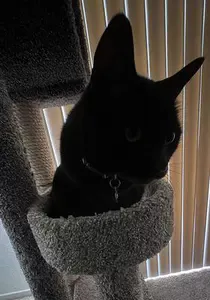Cat Litter Box Training
Cat litter box training, in most cases, is a smooth process.
While there are exceptions, normal, healthy cats are very particular about their bathroom habits, and prefer to use the box over your floor, or your bed.
That is to say, they prefer to use a litter box that meets their criteria of location, litter type, amount, scent and texture, and box cleanliness and size.
Most kittens will take to the box with no problems.
Kittens learn to use the box by watching their mothers, but mother cats are not always around for that.
Usually, though, all they need is mother nature combined with a little encouragement, praise, and positive reinforcement.
In fact, most times "litter box training" is really not training at all.

Simply provide a box that meets the criteria and make sure your cat knows where it is and can get to it easily.
Praise your cat when she uses the box, and you're off and running.
If you're dealing with a new cat or kitten being added to a house with existing pets, then special considerations may be in order. Likewise with a cat or kitten experiencing litter box problems that may need retraining.
Cat Litter Box Training Basics
Here's a box training tip sheet.
Some guides recommend placing your cat in the box, grabbing her paw, and then moving her paw through the litter to stir it up and stimulate a response.
This guide to preventing litter box problems at the Dumb Friends League, however, recommends against this since your cat may not like this experience.
Below are a some basic points to remember about this very important aspect of cat care.
In many cases, providing a box that meets the below criteria and showing it to your cat is all the litter box training you need to do.
- The Importance of the box - Do not underestimate the significance of the box in your cat's life. The litter box is one of the most important things in your cat's life.
Your cat will spend a lot of time in the box, and cats are usually very particular about their box habits. - Box placement - Box placement is extremely important, and involves both location and accessibility.
- Location - The box needs to be placed in an area where your cat frequents, but is also low noise, and low traffic. If your cat is disturbed by people moving about, noisy appliances, or chemical smells, she may learn to dislike the box and not use it.
High traffic kitchens and bathrooms are usually poor choices, as are laundry rooms with noisy washing machines, and garages with stored chemicals.
In multi-pet households, do not place all the litter boxes in one area. One reason for this is to avoid litter box guarding.
Some pets get into territorial disputes, and the litter box becomes a point of contention. If all the boxes are in one area, it's possible that one cat could be restricted from using all the boxes by another pet who is blocking access or ambushing.
This can lead to additional stress, and inappropriate elimination problems. Another reason to place litter boxes in different areas is accessibility. - Accessibility - The box needs to be placed in an area where your cat can easily get to it, and also where she can feel safe. This means that for multi-story houses, a box needs to be on each level of the house.
Make it easy on your cat. If your cat is older, or debilitated due to injury, she may have a hard time getting to the box in time. Also, each box needs to be placed so that your cat has an easy escape route, preferably more than one.
Remember that contrary to rumor, while cats need about 1/6 the amount of light we do in order to see, they cannot see in total darkness. If you hide the litter box away in a closet or basement somewhere then your cat may have problems using it at night.
Place a night light in such a way so that your cat has some light to see by when she uses the box. This may also apply to the litter box furniture that you can purchase to hide the box.
In addition, you should ensure that each litter box is always accessible. Many people place litter boxes in bathrooms or closets. This sometimes results in the box becoming temporarily inaccessible when the door is closed.
This is not advisable. To get around this, if you place the litter box in an area where the door may be closed at times, you should probably install a cat door so that your cat can come and go. - Cleanliness - It's said that cats spend 1/3 of their waking lives grooming themselves. They're extremely clean, and they like their litter boxes to be clean as well.
Their noses are far more powerful than ours, and you can never assume that just because the box doesn't smell to you, that it doesn't smell to them.
Clean the litter box at least daily, more if you can. With clumping clay litter, you'll notice that as the litter absorbs more and more moisture over time it will become darker in color, and you can usually tell from that when the litter needs to be changed.
For clumping, scoopable clay litter, replace the litter entirely at least every 2 to 3 weeks, regardless of color, and clean the box thoroughly when you do.
Never use products, such as disinfectants, that contain phenols to clean the box. In fact, Lysol and some other household products are toxic to cats.
Soap and water works fine, and you can then use a 1 to 30 bleach solution to disinfect. Some people have suggested that bleach is bad for cats, but a number of veterinary expert sources recommend using bleach with confidence.
The key is to thoroughly rinse and dry the box to remove any trace of bleach smell, since cats are sensitive to the smell of bleach. - Number of Boxes - In addition to a litter box on each level of the house, you should follow the one plus one rule. That is, one litter box for each cat in the house, plus one more.
Even for one cat, placement issues can be a problem. If you have only one box in a busy house, this can, over time, cause box avoidance issues. Place another box in a quiet area.
This also allows the cat to use one box for urination and one for defecation, which some cats prefer. - Type and Size of Box - For kittens or cats with mobility problems, it's obviously easier to get in and out if the box is lower. Larger cats need a larger box in order to position themselves correctly and still get everything inside the box.
Hooded or covered litter boxes may keep litter from being tossed out onto the floor, but they also may retain smells that your cat doesn't like. In addition, larger cats may find it cramped.
Even if you follow all the rules, things can still go wrong. Your cat could stop using the box, or in rare cases, refuse to use it in the first place. Confinement training to the rescue!
Litter Box Retraining
If your cat stops using the box, you may have to help her retrain herself.
Cats stop using the box for various reasons. With most cats, it doesn't take that much to get them using the box again after a problem has been fixed. After all, cats naturally want to use a sandy substrate to pee, poop, and cover their waste.
Sometimes, however, even after you fix whatever the root cause was, your cat still fails to use the box.
In these cases, the cats may need help getting their bathroom habits back on track. This is where litter box retraining becomes necessary.
For example, perhaps your cat develops what's called FLUTD, or feline lower urinary tract disease. This is an assortment of conditions which may cause pain or straining during urination.
The result is, your cat starts to associate the box with pain and discomfort, and starts urinating outside the litter box. Your cat may get over the episode of FLUTD, but still associate the litter box with pain and continue to urinate outside the litter box.
The cause of the problem is gone, but the behavior remains.
One of our reader's cats had surgery, and afterwards, refused to use the litter box. She resolved her cat's litter box problem by confining her cat to a small room.
We sometimes call this confinement or isolation retraining. This type of litter box retraining starts in the same way bringing a newly adopted cat home does-confining your cat to a single room.
Advantages to using confinement retraining:
- isolates the mess (if any) to one room
- reduces or eliminates territorial issues
- eliminates potential box guarding problems
It can take anywhere from a few days to a few weeks for your cat to start using the box again. Once your cat is regularly using the box, you can give her access to the rest of the house. If there's a setback, it's too soon, and back in the room she goes.
Here's how to retrain your cat to use the litter box again:
Choose a sunny room with a window with a view, and all the amenities.
During the litter box retraining period, this is your kitty's safe room. This will be your cat's world for the next whenever, so set the room up with the following:
- a cat litter box
- cat toys/cat tree
- a nice bed to snooze on
- food and water bowls (placed far away from the litter box)
- a Feliway plug-in diffuser (optional)
- Dr. Elsey's Precious Cat Ultra Litter Attractant (optional, if needed)
- Dr. Elsey's Precious Cat Cat Attract Scoopable Cat Litter (optional, if needed)
Place your cat in this room while you're away from the house and whenever you can't watch her (such as when cooking dinner). If you're not able to let her out for extended periods, then spend a lot of time in there with her. Exercise her with some interactive toys, like Da Bird, or just keep her company.
If you're worried your cat will be lonely or bored when you can't be with her, you can get a cat DVD, like video catnip, and let it play for your cat.
Other options are Mewvie, The The Motion Picture for Your Cat: Episode 1 Backyard Buffet, and Cat Dreams. These DVDs have squirrels, birds, and nature sounds that can keep your kitty entertained.
When you can supervise her, you can let your cat out of the room, but you'll need to watch out for signs she's going to do her business. If it seems like she's heading for her usual spot, bring her to the safe room and place her in the box (very much like you'd train a kitten).
Whenever she uses the box, praise her like it's the best thing she's ever done in her life.
Note: If your cat doesn't use the box while in the safe room, you may have to use a smaller room, such as a bathroom, or a large cage to keep her from soiling the area.
Once your cat is regularly using the box, you can let her have access to the rest of the house again. Remember, if she has a setback, start the process over.
Phew! That was a lot of litter box training talk. Let's wrap it up...
Although cat litter box training is usually easy, there can be some bumps in the road. and there are some things you can do to prevent or remedy a litter box problem. Following the above guidelines and considerations should help make things go more smoothly.
Many litter box problems are caused by medical issues. Your litter box training efforts will not be effective if there's a medical issue, and you'll need to consult with a veterinarian to solve those problems.
A urinary tract infection, feline constipation, or even hairballs can cause your cat problems. Diarrhea is also another physical problem that can throw your cat off the box.
If there is a problem either during training or later on, the first step is always to make sure it's not medical and have a consultation with your veterinarian.
If your cat stops using the litter box, you'll need to address the cause first. After you've remedied the cause, your cat should start using the box again. If not, you should be able to retrain your cat using confinement as described above.
To deal with persistent or challenging behavioral issues that cause your cat to urinate or defecate outside the box, litter box training or retraining may not be enough. You may need to consult with an animal behaviorist or pet psychologist.
Topics Related To Litter Box Training
Cat Litter Box
Cat Lovers Only


Comments: What do you think?
Have your say about what you just read. Leave me a comment in the box below.